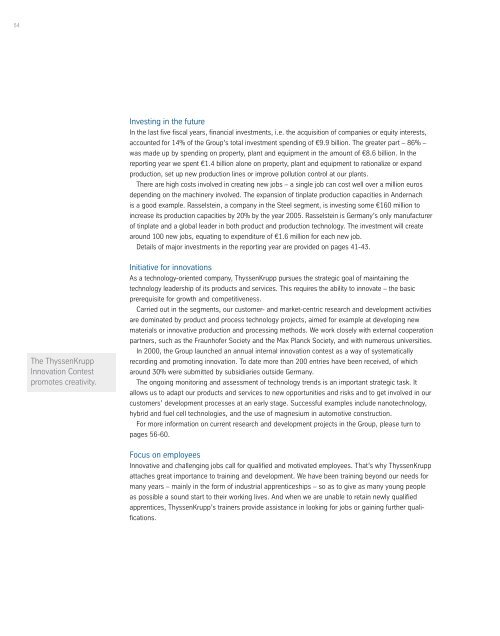Annual Report 2003 2004
Annual Report 2003 2004
Annual Report 2003 2004
You also want an ePaper? Increase the reach of your titles
YUMPU automatically turns print PDFs into web optimized ePapers that Google loves.
54<br />
The ThyssenKrupp<br />
Innovation Contest<br />
promotes creativity.<br />
Investing in the future<br />
In the last five fiscal years, financial investments, i.e. the acquisition of companies or equity interests,<br />
accounted for 14% of the Group’s total investment spending of €9.9 billion. The greater part – 86% –<br />
was made up by spending on property, plant and equipment in the amount of €8.6 billion. In the<br />
reporting year we spent €1.4 billion alone on property, plant and equipment to rationalize or expand<br />
production, set up new production lines or improve pollution control at our plants.<br />
There are high costs involved in creating new jobs – a single job can cost well over a million euros<br />
depending on the machinery involved. The expansion of tinplate production capacities in Andernach<br />
is a good example. Rasselstein, a company in the Steel segment, is investing some €160 million to<br />
increase its production capacities by 20% by the year 2005. Rasselstein is Germany’s only manufacturer<br />
of tinplate and a global leader in both product and production technology. The investment will create<br />
around 100 new jobs, equating to expenditure of €1.6 million for each new job.<br />
Details of major investments in the reporting year are provided on pages 41-43.<br />
Initiative for innovations<br />
As a technology-oriented company, ThyssenKrupp pursues the strategic goal of maintaining the<br />
technology leadership of its products and services. This requires the ability to innovate – the basic<br />
prerequisite for growth and competitiveness.<br />
Carried out in the segments, our customer- and market-centric research and development activities<br />
are dominated by product and process technology projects, aimed for example at developing new<br />
materials or innovative production and processing methods. We work closely with external cooperation<br />
partners, such as the Fraunhofer Society and the Max Planck Society, and with numerous universities.<br />
In 2000, the Group launched an annual internal innovation contest as a way of systematically<br />
recording and promoting innovation. To date more than 200 entries have been received, of which<br />
around 30% were submitted by subsidiaries outside Germany.<br />
The ongoing monitoring and assessment of technology trends is an important strategic task. It<br />
allows us to adapt our products and services to new opportunities and risks and to get involved in our<br />
customers’ development processes at an early stage. Successful examples include nanotechnology,<br />
hybrid and fuel cell technologies, and the use of magnesium in automotive construction.<br />
For more information on current research and development projects in the Group, please turn to<br />
pages 56-60.<br />
Focus on employees<br />
Innovative and challenging jobs call for qualified and motivated employees. That’s why ThyssenKrupp<br />
attaches great importance to training and development. We have been training beyond our needs for<br />
many years – mainly in the form of industrial apprenticeships – so as to give as many young people<br />
as possible a sound start to their working lives. And when we are unable to retain newly qualified<br />
apprentices, ThyssenKrupp’s trainers provide assistance in looking for jobs or gaining further qualifications.

















